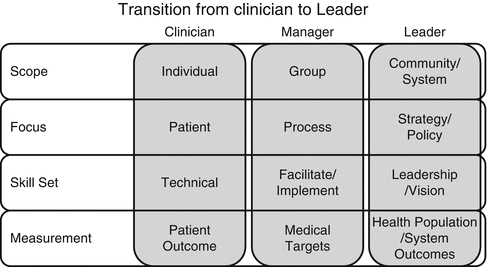Passion and Promise to Lead
Brings Out the Best in People
Authenticity
Receptivity to Feedback
Learning Agility
Culture Fit
Adaptability
Conceptual Thinking
Navigates Ambiguity
Passion for Results
The transition from clinician with a recognized technical expertise to a leader is a journey, not a specific destination endpoint. Clinicians typically have the responsibility for a distinct service area, whereas the leader or leadership team requires a cross-disciplinary vision of the entirety of the service line or hospital system (Fig. 17.1). For the leader this will likely require a ‘we” rather than “me” perspective. The author Ken Blanchard writes about “servant leadership” [6] in which leaders realize their main role is to help people and organizations achieve collective goals. This requires an emphasis on communication and vision.


Fig. 17.1
The transition from clinician to manager to leader
Leadership Development
Physician leaders may seek to gain leadership expertise through several avenues, the first, a formal process of a Master’s of Business Administration (MBA) or Public Health (MPH) degree. These programs offer curricula including, but not limited to, accounting, business strategy, economics, finance, human resources, marketing management, manufacturing and production, operations management, statistics and technology, and information systems. An MBA degree augments leadership but does not guarantee effectiveness. To succeed within the co-management model for healthcare administration, the physician manager should be conversant and knowledgeable in these business metrics. Another option is the Cardiovascular Leadership Institute, developed by the American College of Cardiology [7]. This process assists cardiovascular professionals as they develop into effective and visionary leaders. A third choice is by way of the American College of Physician Executives, which offers formal classroom and on-line education courses to advance physician business and operational knowledge. Gaining the foundational knowledge of leadership principles and practices is extremely important. Spending time and money on this type of development demonstrates that the organization recognizes leadership as a separate and distinct discipline with its own set of theories, models, skills, and behaviors.
Beyond foundational knowledge lies working knowledge. This type of knowledge gained from experience can only be learned “on-the-job”. Acquiring this experience can be accelerated by carefully selecting development assignments. Assignments can take the form of leading or participating on a steering committee, leading a project team, or taking responsibility for parts of a larger entity, to name a few. The role of coaching and mentoring as an accelerator cannot be overstated. Emerging leaders need people they can turn to when they are confronted with organizational and operational challenges they have never faced before. These coaches and mentors should go beyond “giving advice” to a model that encourages physicians to reflect on and frame what they are experiencing. Once they have done this critical step they can move toward generating ideas and solutions they feel they can own and implement. The opportunity to develop as a leader, on the job under the guidance of a physician leader as mentor, may rapidly accelerate competency within the culture of the organization.
Leadership Collaboration
A physician leader must see administrative managerial responsibilities and the interface with hospital or practice administration as legitimate important responsibilities, not simply a time filler between patient encounters. Administrative leaders (practice and/or hospital) face a cultural challenge, meeting with physician and non physician leaders to define strategy and operations. Physician and administrator (or nursing) co-leaders assume accountability and credit for their respective areas of expertise within the whole of the enterprise and they collectively succeed or fail. A dyad management model for integrated health systems (Fig. 17.2) defines the relationship between qualified physician and non-physician leadership partners. These two co-managers provide unique perspectives, different skillsets and specialized expertise that should synergistically define strategy, clinical performance, and business metrics. The key role of the physician leader is to define clinical vision and to manage physician teams’ performance and behavior. The administrative partner is primarily more focused on operations, business, staffing, and support systems and services. Together these dyad leaders define mission, vision, values, culture, overall performance, internal organization relationships, and finally strategy.


Fig. 17.2
Roles for physician and admin co-managers within the dyad management model (Image used with permission from ACPE.org – Zismer DK, Brueggemann J. Examining the “Dyad” as a Management Model in Integrated Health Systems. PEJ. January*February/2010)
Leadership Teams
In contrast to classic physician training, which often emphasizes the physician as an independent operator, this new leadership role by necessity requires participation as part of a high performing team. Being one part of a larger team is not a value set or skillset generally nurtured during medical school or residency, nor may it be of particular interest for clinical or academic practicing physicians. In Patrick Lencioni’s book The Five Dysfunctions of a Team [8], the strategy around which teams either fail or succeed is well described. The role of the leader, or in the case of the dyad model the co-leaders, is to develop team performance. The best teams will demonstrate vulnerability-based trust, clarity, constructive confrontation, and a focus on productive discussions and decisions and team outcomes. Communication within teams becomes even more important during discussions and decisions. Teams need to know in advance how decisions will be made: consensus, majority vote, or by executive decree. Regardless, team members need to support group decisions. Physician leaders would be well advised to direct much of their leadership development time on enhancing communications. Books such as Crucial Conversations [9] provide simple, but powerful, strategies for enhancing discussions involving negotiations or potentially confrontational discussions with “good physicians with bad behavior”. Lencioni believes that the role of the leader, or the dyad leadership, is to “go first”. Leaders must model trust with one another and the team and skillfully lead discussions in a vulnerable fashion.
Defining Organizational Culture
The role of organizational culture in which to develop physician and administrative leaders cannot be underestimated. Culture can be described as a set of shared attitudes, values, goals and practices. Successful organizations take care to define values and behaviors that constitute the desired culture in order to achieve their stated vision. Physician behavior is at the core of either reinforcing or undermining the culture in a practice, and thus “culture fit” is one of the most, if not the most, important aspect of hiring new physicians with leadership potential and identifying internal high potential physicians.
Hirschfield and Moss [10] suggest that to reduce the chances of a culture clash, it is imperative to identify leaders on both sides who can provide models of behavior that represent the new desired culture. A multi-step process to ensure culture alignment may include:
1.
develop a compelling and measurable vision for the organization,
2.




listen well to understand perspectives of leadership, staff, patients, and providers,
< div class='tao-gold-member'>
Only gold members can continue reading. Log In or Register to continue
Stay updated, free articles. Join our Telegram channel

Full access? Get Clinical Tree


